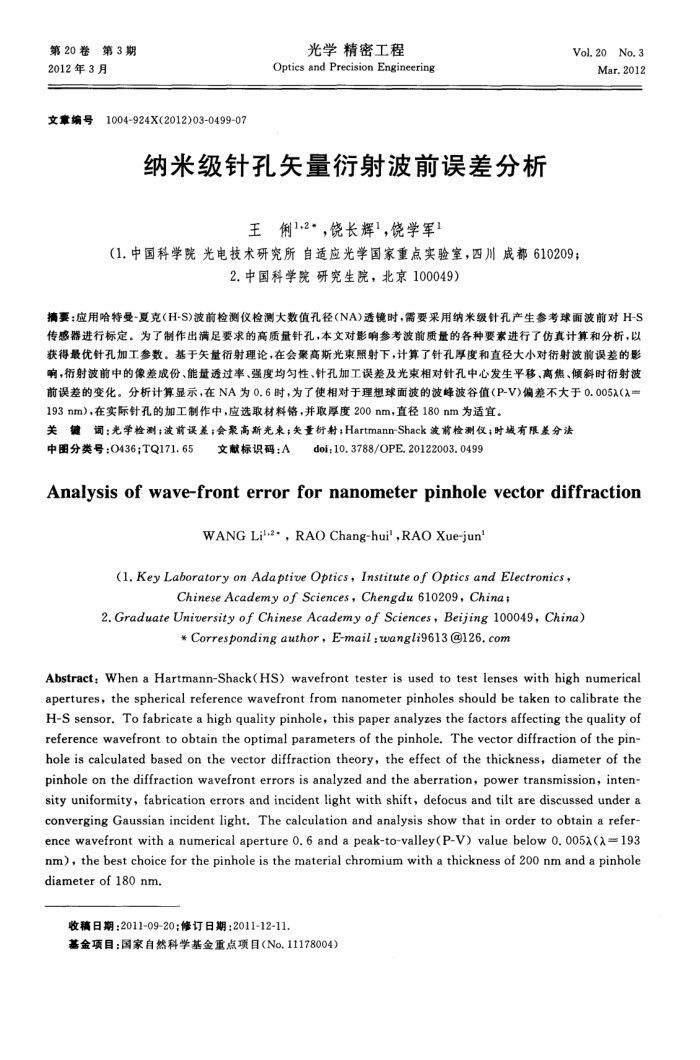您当前的位置:首页>论文资料>纳米级针孔矢量衍射波前误差分析
内容简介
 第20卷第3期 2012年3月
第20卷第3期 2012年3月1004-924X(2012)03-0499-07
文章编号
光学精密工程
Optics and Precision Engineering
纳米级针孔矢量衍射波前误差分析
王俐1,2*,饶长辉1,饶学军
Vol.20No.3
Mar.2012
(1.中国科学院光电技术研究所自适应光学国家重点实验室,四川成都610209;
2.中国科学院研究生院,北京100049)
摘要:应用哈特曼-夏克(H-S)波前检测仪检测大数值孔径(NA)透镜时,需要采用纳米级针孔产生参考球面波前对H-S 传感器进行标定。为了制作出满足要求的高质量针孔,本文对影响参考波前质量的各种要素进行了仿真计算和分析,以获得最优针孔加工参数。基于失量衍射理论,在会聚高斯光束照射下,计算了针孔厚度和直径大小对衍射波前误差的影响,衍射波前中的像差成份、能量透过率、强度均匀性、针孔加工误差及光束相对针孔中心发生平移、离焦、倾斜时衍射波前误差的变化。分析计算显示,在NA为0.6时,为了使相对于理想球面波的波峰波谷值(P-V)偏差不大于0.005>(入 193nm),在实际针孔的加工制作中,应选取材料铬,并取厚度200nm,直径180nm为适宜。
关键
词:光学检测;波前误差;会聚高斯光束;失量衍;Hartmann-Shack波前检测仅;时域有限差分法
中图分类号:0436;TQ171.65
文献标识码:A
doi:10.3788/OPE.20122003.0499
Analysisofwave-fronterrorfornanometerpinholevectordiffraction
WANG Lil-2· , RAO Chang-hui',RAO Xue-jun'
(l.KeyLaboratoryonAdaptiveOptics,Instituteof OpticsandElectronics,
ChineseAcademyof Sciences,Chengdu610209,China;
2.GraduateUniversityofChineseAcademyofSciences,Beijing1o0049,China)
*Correspondingauthor,E-mail:wangli9613@126.com
Abstract: When a Hartmann-Shack(HS) wavefront tester is used to test lenses with high numerical apertures, the spherical reference wavefront from nanometer pinholes should be taken to calibrate the H-S sensor. To fabricate a high quality pinhole, this paper analyzes the factors affecting the quality of reference wavefront to obtain the optimal parameters of the pinhole. The vector diffraction of the pin-hole is calculated based on the vector diffraction theory, the effect of the thickness, diameter of the pinhole on the diffraction wavefront errors is analyzed and the aberration, power transmission, inten-sity uniformity, fabrication errors and incident light with shift, defocus and tilt are discussed under a converging Gaussian incident light. The calculation and analysis show that in order to obtain a refer-ence wavefront with a numerical aperture 0. 6 and a peak-to-valley(P-V) value below 0. 005>(入=193 nm), the best choice for the pinhole is the material chromium with a thickness of 2o nm and a pinhole diameterof 180 nm.
收稿日期:2011-09-20:修订日期:2011-12-11.
基金项目:国家自然科学基金重点项目(No.11178004)
上一章:线性菲涅尔式聚光系统的镜场布置与优化
下一章:压电陶瓷微动台的复合控制
相关文章
离轴抛物镜检测中调整误差对波前畸变的影响
零阿贝误差的纳米三坐标测量机工作台及误差分析
数控机床热误差的动态自适应加权最小二乘支持矢量机建模方法
GB/T 38531-2020 微束分析致密岩石微纳米级孔隙结构 计算机层析成像(CT)分析方法
GB/T 38531-2020 微束分析致密岩石微纳米级孔隙结构计算机层析成像(CT)分析方法
GB/T 38531-2020 微束分析 致密岩石微纳米级孔隙结构计算机层析成像(CT)分析方法
GB/T 37054-2018 纳米技术纳米二氧化钛中锐钛矿型与金红石型比率测定 X射线衍射法
GB/T 37054-2018 纳米技术 纳米二氧化钛中锐钛矿型与金红石型比率测定 X射线衍射法